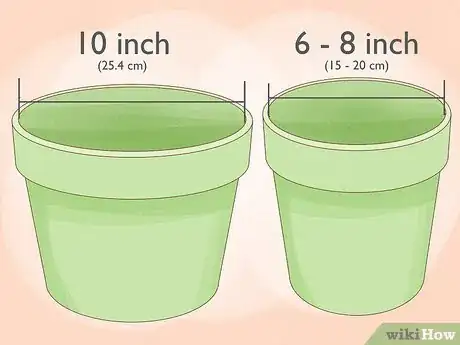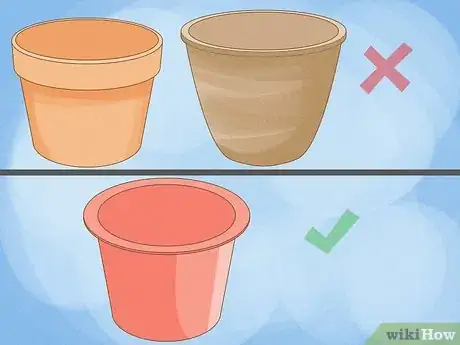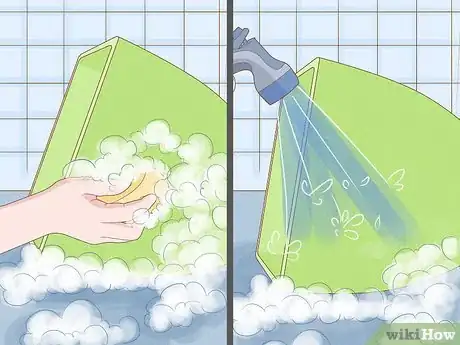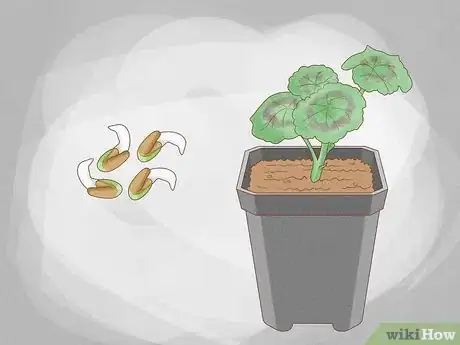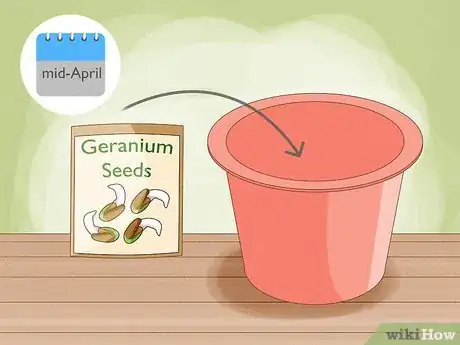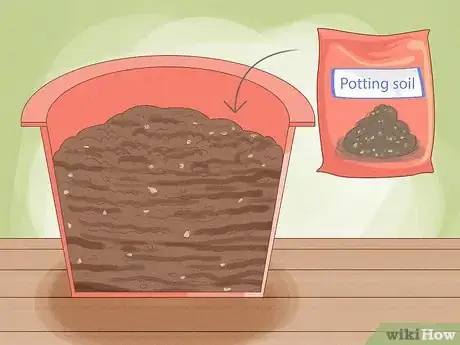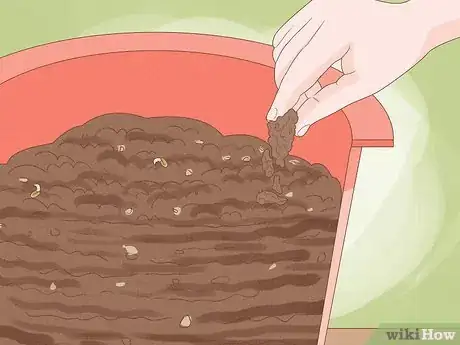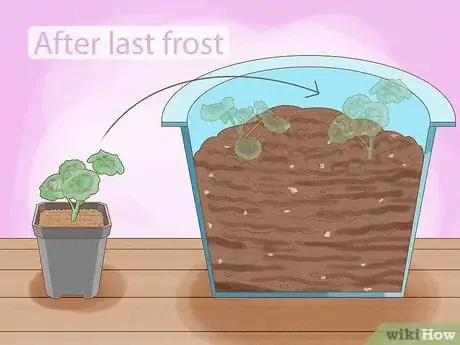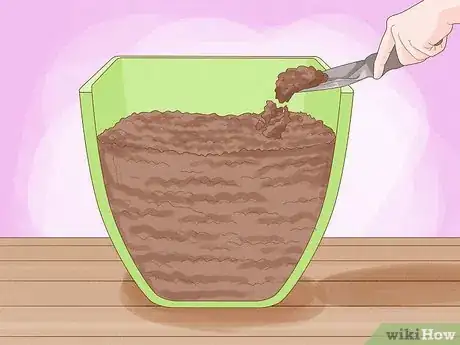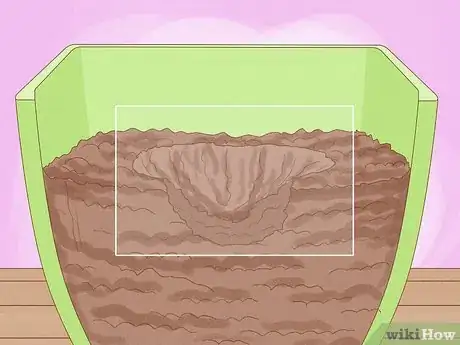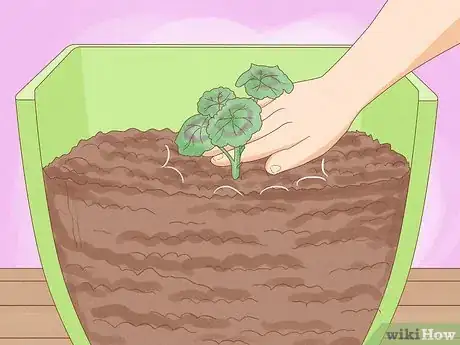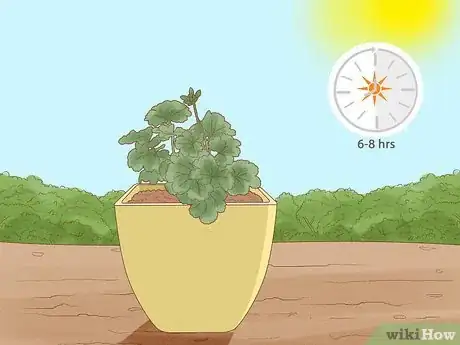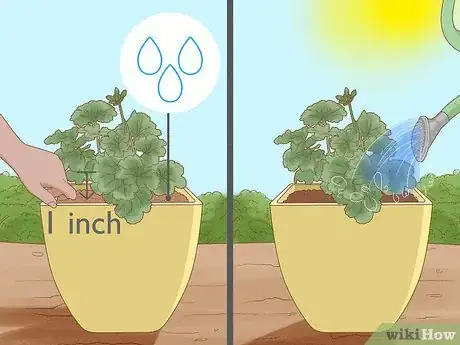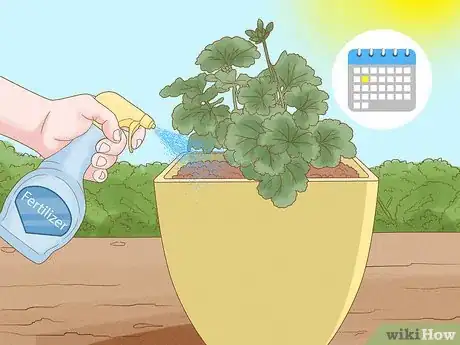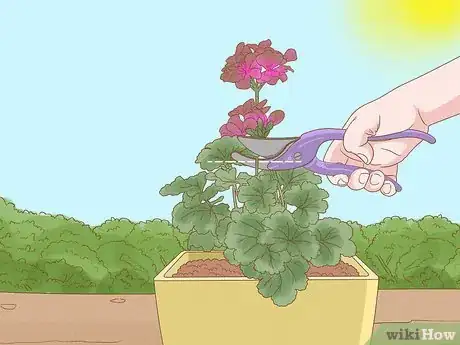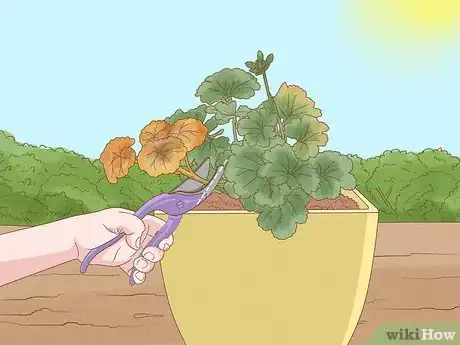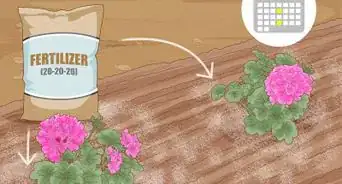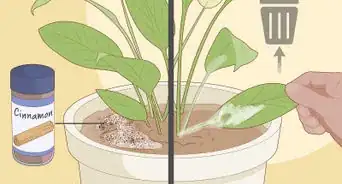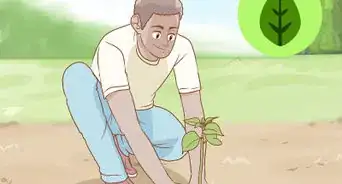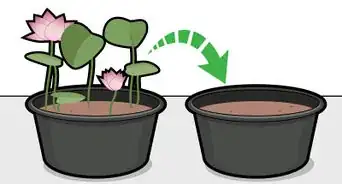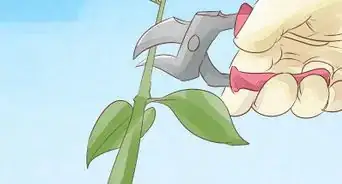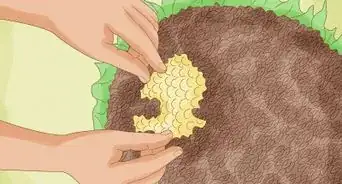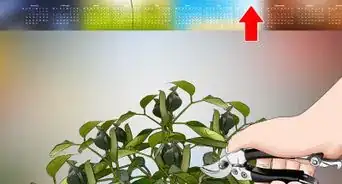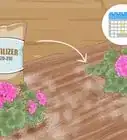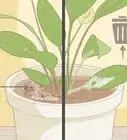wikiHow is a “wiki,” similar to Wikipedia, which means that many of our articles are co-written by multiple authors. To create this article, 18 people, some anonymous, worked to edit and improve it over time.
wikiHow marks an article as reader-approved once it receives enough positive feedback. This article has 12 testimonials from our readers, earning it our reader-approved status.
This article has been viewed 136,172 times.
Learn more...
Colorful geraniums make a wonderful addition to container gardens. The blooms, which usually appear in pink, purple, white, or red flower clusters last from mid-spring to early fall when cared for properly.
Steps
Preparation
-
1Choose a pot with holes in the bottom. Geranium roots will rot if they sit in water for an extended period of time, so adequate drainage is essential.[1]
-
2Select a pot that fits the size of the plant. Many varieties can fill a 10-inch (25.4-cm) pot, but some smaller varieties can thrive in a 6- to 8-inch (15- to 20-cm) pot. These flowers do well when the roots don't have the option of spreading too far, but they must still have adequate room to develop.Advertisement
-
3Pick a pot made with a material that suits your needs. If you plan on moving the plant around, avoid heavier clay pots and stick to plastic.
-
4Clean the pot. Dirty pots may contain bacteria or insect eggs that are too small for the naked eye to see. These hidden dangers could prevent your flowers from reaching their full potential.
-
5Decide what method you want to use to start your flowers. Using cuttings from mother plants or purchasing seedlings at a garden store are the easiest methods of starting a potted geranium, but you can also use seed.
-
6Choose a good quality soil. A cheap soil may retain too much moisture, which will lead to root rot once you plant your geraniums. These flowers thrive best in soil that drains well, especially if it contains traces of organic material.
Planting from Seed
-
1Start geraniums from seed indoors. Early to mid-April is usually standard. Once the seeds start to sprout, you can move them outdoors. Just make sure that the last frost of the season has already passed.
-
2Fill the pot with soil. Allow the soil to remain fairly loose, as tightly packed soil can suffocate the plant.[2]
-
3Spot the top of the soil with seeds. Space seeds a few inches apart from one another. This space is necessary to ensure that the flowers will have room to grow without suffocating another's roots.
-
4Cover the seeds with soil. Only apply a light layer of soil, as too much soil may prevent the seeds from germinating.
Planting from Cuttings or Seedlings
-
1Plant seedlings or cuttings after the last frost passes. They can be kept either indoors or outdoors.
-
2Fill your chosen pot with soil. Leave the soil loose so the plant's roots have room to breathe.[3]
-
3Dig a shallow hole in the soil. It should be just large enough to rest the seedling's root system in. The general rule of thumb is that the seedling should be as deep in your soil as it was in the original container. Do not plant the seedling any deeper, since stems can actually begin to rot and decay if covered by soil.
-
4Pack the soil around the geranium to hold it in place. Do so carefully to avoid breaking or tearing the stem of the plant, since a damaged stem weakens the integrity of the plan and provides an opening for diseases to enter in.
Care
-
1Place the pot in full sun. Geraniums require six to eight hours of direct sunlight to thrive, but some varieties prefer a bit of shade in the afternoon.[4]
-
2Allow the soil get dry in between each watering.[5] Test the soil by poking your finger into the top inch. If the soil is dry all the way through the top inch, provide the flowers with enough water to dampen the soil without soaking it.
-
3Fertilize your geraniums once a month using a liquid fertilizer. An abundance of fertilizer will cause your geraniums to produce many strong, healthy leaves, but it will also prevent blooms from developing and may lead to a plant with minimal flowering.
- You can also use a slow-release, granular fertilizer. Only apply this fertilizer once, during the spring.
-
4Remove dying flowers regularly. You can usually tell when a flower is dying because the color fades and the blossom begins to wilt. The removal of dead flower heads will encourage the plant to continue blooming.[6]
-
5Remove brown leaves and faded stalks to minimize the risk of fungal disease. Decomposed leaves and stalks are likely to cause "Botrytis" or other fungi to form.
Community Q&A
-
QuestionHow much water does a geranium need?
 Community AnswerDepends on your region and weather. It calls for water after you poked your finger an inch deep and found it dry. Just water as much as the upper inch needs in order to dampen the soil ball not soak it.
Community AnswerDepends on your region and weather. It calls for water after you poked your finger an inch deep and found it dry. Just water as much as the upper inch needs in order to dampen the soil ball not soak it. -
QuestionWhat would cause only a few of the blooms to open?
 Kristin SharpCommunity AnswerPerhaps you didn't pull dead growth off. Or, maybe they're root bound and need more room for roots to spread out.
Kristin SharpCommunity AnswerPerhaps you didn't pull dead growth off. Or, maybe they're root bound and need more room for roots to spread out. -
QuestionI have red geraniums that are in a pot. They come back after winter. However, this spring, the flowers are "white." What do they need?
 Kristin SharpCommunity AnswerFeed them very little, so as not to burn the roots. But, if they outgrow the pot, you may need to put them in the ground or a bigger pot. They can get root bound and the roots have nowhere to go once it gets big enough.
Kristin SharpCommunity AnswerFeed them very little, so as not to burn the roots. But, if they outgrow the pot, you may need to put them in the ground or a bigger pot. They can get root bound and the roots have nowhere to go once it gets big enough.
Warnings
- Bacterial blight can destroy your geraniums, causing them to wilt for no apparent reason. There is no spray that can cure this disease, and infected plants should be removed from the area to avoid contamination of other plants.⧼thumbs_response⧽
- High summer heat can severely harm geraniums. Many varieties stop blooming when the temperature is too high, but the flowers will return with the cooler weather.⧼thumbs_response⧽
Things You'll Need
- Small- to medium-sized pot
- Soil
- Geranium seeds
- Geranium seedlings or cuttings
- Balanced liquid fertilizer
- Slow-release granular fertilizer
References
- ↑ https://www.almanac.com/plant/geraniums
- ↑ https://gilmour.com/geranium-care#Tips-for-Planting-Growing-Caring-for-Geraniums
- ↑ https://www.almanac.com/plant/geraniums
- ↑ https://www.southernliving.com/home-garden/gardens/plant-geraniums-containers
- ↑ https://www.southernliving.com/home-garden/gardens/plant-geraniums-containers
- ↑ https://www.almanac.com/plant/geraniums
- Southern Living: Plant Geraniums in Containers
- Balcony Container Gardening: How to Grow and Care for Geraniums in Containers
About This Article
Growing geraniums in pots will give you colorful blooms that you can enjoy from spring until fall. Pick a pot with holes in the bottom for adequate drainage and that’s between 6 and 10 inches, depending on the variety. The easiest way to start your flowers is to use cuttings from mother plants or buy seedlings at a garden store, but you can also use seeds. Use a good quality soil when you’re ready to plant, making sure it drains well to avoid root rot. Give your plant full sunlight and allow the soil to get dry between watering. When the soil is dry all the way through the top inch, give the flower enough water to dampen the soil. Once a month, give your plant liquid fertilizer to help it grow strong. When you see flowers dying, remove the flower heads to encourage the plant to keep blooming. To learn how to prevent fungal disease in your geranium, keep reading!

